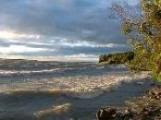Lots property owners can do to preserve moraine
The Oak Ridges Moraine requires stewardship from the people who own land on it, and there are a number of ways to provide it.
People in Schomberg heard about some of them Thursday night at the stewardship program hosted by the Caring for the Moraine project.
A couple of local landowners offered insight on the steps they have taken to preserve the environment around their spreads.
Phil Chadwick, who has owned 25 acres on the west side of the township for 14 years, commented on some of the work he's been doing there.
The meteorologist, bee keeper and part-time farmer and writer said his property is on the crest of the moraine, with his front yard draining toward Lake Simcoe and the back yard toward Lake Ontario.
"When we arrived, the land needed a lot of love," he commented, stating there were only seven trees on the site when he bought it. He's since planted some 5,000 there, and hopes his property will eventually house a forest.
"The world is like a great big sandbox and we have to learn to share the sand, not just our fellow humans, but with nature," he told the audience.
Chadwick said there had been a timber operation of the site years ago, with a pond there used to keep the wood wet. The levelling of the trees, he said resulted in the property looking like a moonscape.
While the local conservation authorities helped restore the site, Chadwick said he and his family did the bulk of the work themselves.
"You've got to be patient," he said.
He also said he uses no pesticides on the property. He gets a lot of dandelions, but that's not much of a problem as his bees love them.
It's not just trees and dandelions that are benefitting from his efforts. Chadwick said they have about 200 bird houses set up around the property.
There are a host of other animals around too, including wild turkeys. One can sometimes see between 30 and 40 of them around the site. "You give them the habitat, you give them the food and they'll come," Chadwick explained.
Those aren't the only birds around the property. Chadwick said they have nesting platforms for mallards and nesting boxes for owls, and the odd trumpeter swan makes an appearance.
There are also deer there. Chadwick said they use the planted hardwood trees to sharpen their antlers. That doesn't do the trees a lot of good, but he observed that's just part of nature.
Other species on this land include mink, muskrat, beaver and a host of amphibians.
"All we have to do is play in the sandbox with nature, all in balance," he said. "It's paradise."
The meeting also heard from Jane Glassco, and the work she's been doing on 268 acres on the 12th Concession.
She said her parents bought the property in 1946, and much work was needed to restore the neglected, 100-year-old house.
The property now contains a completely organic sheep farm.
She cited back to 1989, when Health Canada sent a team to the Arctic to find people who had never been exposed to chemicals. They found Inuit people, who lived on things like seal, fish and caribou, hoping to use them as a source of base-line data, and what they found was a variety of chemical in their systems, including a pesticide that was only used in cotton fields in Georgia. In some cases, there were concentrations 200 times in excess of what people elsewhere in the country carry.
Glassco said that shows that chemicals can travel anywhere in the world, through the air or water, or though the food chain.
She said there are about 100 yews on her operation.
There's a forest management plan in place too. Glassco said her parents started to grow trees in the '40s and '50s to combat erosion on the property.
Glassco also said there was recently an agreement reached with the Oak Ridges Moraine Land Trust to place the property in a conservation easement.
Brian Peterkin, who is involved in environmental stewardship in York for the Ministry of Natural Resources, told the audience there are a number of organizations involved in the Caring for the Moraine project, including various conservation authorities, Oak Ridges Trail Association, the moraine land trust, and Nature Conservancy of Canada.
Kim Gavine, executive director of the Oak Ridges Moraine Foundation, explained the project started about three years ago, when numerous stakeholders formed the Oak Ridges Moraine Stewardship Partners' Alliance, which came up with a restoration strategy.
The objectives include increasing natural cover on the moraine, protect water systems and raise awareness.
Gavine said there are 27 conservation partners working on this project, and they cover a wide range. Some have very specific areas of knowledge while others are more broadly based. There are government and nongovernment organizations involved, and others that are specifically interested in the moraine while others that have a broader focus.
She also stressed involvement in the program is voluntary, adding it's aimed at assisting landowners. Gavine said they're not trying to impose new regulations on the moraine or create new programs.




2 Comments:
Our packers and movers in Bangalore will charge you very reasonable and genuine for moving to another destination.
Packers and Movers India
http://moverspackersonline.com/packers-and-movers-bangalore/
http://moverspackersonline.com/packers-and-movers-delhi/
http://moverspackersonline.com/packers-and-movers-hyderabad/
http://moverspackersonline.com/packers-and-movers-chennai/
http://moverspackersonline.com/packers-and-movers-mumbai/
http://moverspackersonline.com/packers-and-movers-pune/
http://moverspackersonline.com/packers-and-movers-noida/
http://moverspackersonline.com/packers-and-movers-gurgaon/
http://moverspackersonline.com/packers-and-movers-ghaziabad/
http://moverspackersonline.com/packers-and-movers-faridabad/
Our related packers and movers Bangalore will pack your everything things and movement them securely, best case scenario cost.
packers and movers in bangalore
packers and movers in delhi
packers and movers in hyderabad
packers and movers in mumbai
packers and movers in chennai
Post a Comment
<< Home